Indistylemen
Alternative Ties for Men: What They Are and When to Wear Them
- Get link
- X
- Other Apps
The necktie is a prime focus for us here at the Gentleman’s Gazette–we’ve devoted a number of articles and videos on our channel to how to tie bow ties and various kinds of necktie knots, and we sell a wide array of ties in the Fort Belvedere Shop. But of course, there are a great many other neckwear styles out there aside from the regular neckties and bow ties, which begs the question: are there situations where any of these other styles can or should be worn?
In this guide, we’ll discuss styles of neckwear that go beyond the typical long ties and bows, where they come from, and when or if you should wear them today.
Cravats & Ascots
Cravat
Cravat is an umbrella term for any cloth that is tied around the neck for decorative purposes. As such, it is in a sense the forefather of the necktie, the bow tie, scarves, and most other types of neckwear.
The name cravat is derived from Croatian or “Croat” mercenaries who fought during the Thirty Years’ War of 1618-1648. These mercenaries came into contact with the French, who were impressed by their colorful neckerchiefs. Over time, the French term “Croate”, in reference to the neckwear, became “cravat.” Of course, the fashion of wearing something around one’s neck decoratively dates back much further than the 17th century, but these Croatian mercenaries were the ones who really popularized it.

Formal Ascot or Cravat from Fort Belvedere
In British English, the term cravat or krəˈvæt/ also day cravat usually refers to a more informal type of day ascot that’s worn under the collar of the shirt. This is in contrast to the dress ascot, also called a dress cravat, formal ascot, or plastron. These terms refer to a more structured neckband with wide pointed ends, usually made of silk.
The Royal Ascot Race meeting at the Ascot Racecourse in the British town of Ascot, gave the neckwear its name, although such dress cravats were no longer worn with morning dress at the Royal Races by the Edwardian era. The dress ascot is now worn almost exclusively with formal day wear or morning dress. And if you’d like to learn more, we have be sure sure to check our guide to day cravats and formal ascots, as well as how to tie them.
With those forms out of the way, let’s dig into the more niche and obscure neckwear options found throughout history, next.
Stock Tie
The stock is a close cousin of the ascot and cravat, which comes in two varieties. The shaped stock, which is a single, long, pre-sewn piece of fabric with no folds, with a slit in its center back to facilitate tying and the older “folded stock,” which is folded lengthwise and pressed but not stitched. These folded stocks were originally white neckbands of starched linen or muslin, first worn around 1730. They would later incorporate colors and patterns and become more similar to modern day cravats.
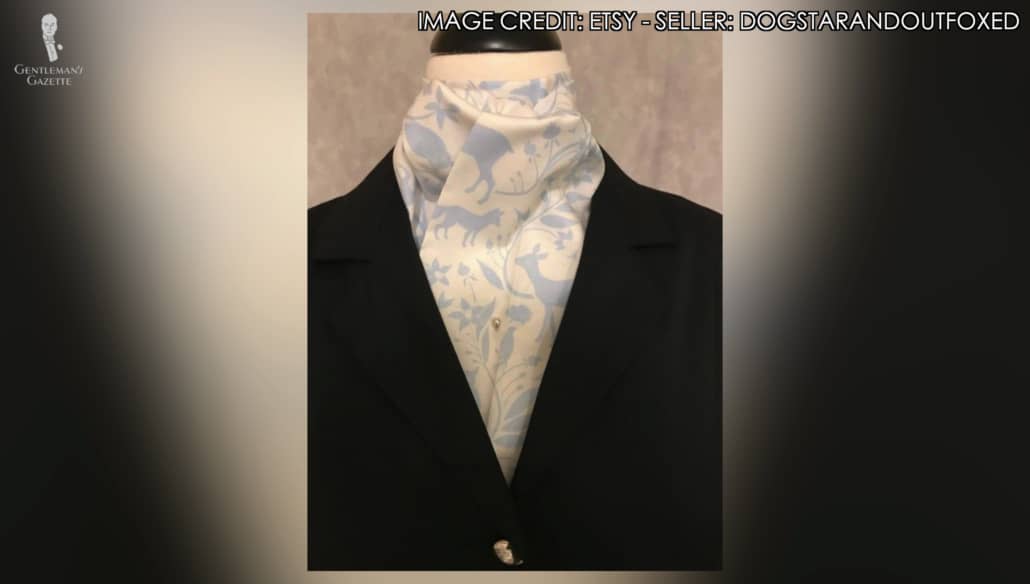
Four-Fold Stock Tie – Foxhunting Traditional
Meanwhile, shaped stocks, which are also called dress stocks or hunting stocks, are more similar to formal ascots, are plain white, and are worn with stock pins. Stock pins, by the way, are horizontal pins, resembling large safety pins of about three inches or so, and are usually gold. They secure the ends of a dress stock together in a similar fashion to how a stick pin is used with a formal ascot.
Stocks are most often worn today as part of British hunting attire, with shaped versions being worn as part of formal fox hunting attire, and folded versions worn with the less formal dress code known as “rat catcher.” Hunters and horsemen often endorse the utility of the stock, saying that when necessary, it can be used to improvise bandages, slings, and other such devices.
Steinkirk Cravat

Portrait of an Unknown Man wearing a Steinkirk Cravat
One more cravat style to cover here: the Steinkirk cravat, also called a Steenkerque. This is a white stock with long ends which are twisted together and pulled through the wearer’s lapel buttonhole, somewhat casually. This style takes its name from the Battle of Steenkerque, between France and a joint force of English, Scottish, Dutch, and German forces on August 3, 1692.
Legend has it that the French were surprised at their encampment early in the morning by the opposing forces, and thus were only partly dressed at that time. The French would go on to win the battle, though, and the casual style of cravat-wearing would remain popular in the region for another handful of decades. If you tie a black ribbon over the top of a stock, you get a style called a “solitaire,” bringing us into our next neckwear category.
Ribbon and String Ties
Simple String Tie
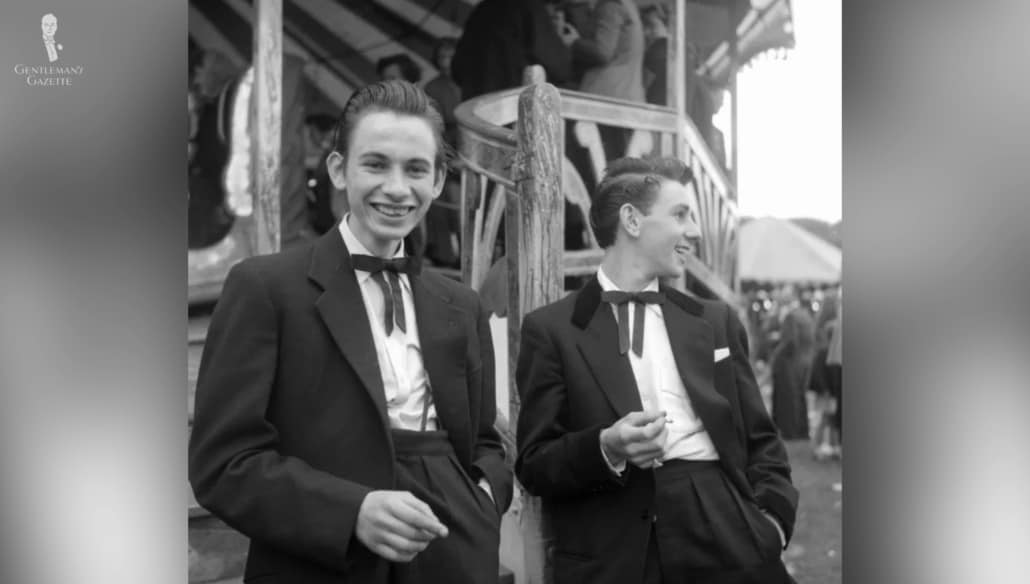
Two Teddy Boys at a funfair wearing a String Tie – Ken Russell’s ‘The Last of the Teddy Girls’
First up here is the simple string tie, also called a bootlace tie or a sheriff’s tie predominantly in the UK. This is just as it sounds: a string that’s looped in a bow rather than being traditionally knotted. It was particularly associated with the Teddy Boy Movement in Britain in the 1950s which was itself an outgrowth of Neo-Edwardian and rockabilly fashions, and it’s often misidentified as a bolo tie.
Bolo Tie
A bolo tie also called a bola tie or shoelace tie is a style of neckwear created from a length of cord that’s almost always leather rather than a strip of silk or other fabric and closed with a jewelry-like side clasp. It usually features decorative metal tips, called aglets which is where the “shoelace tie” moniker comes from.
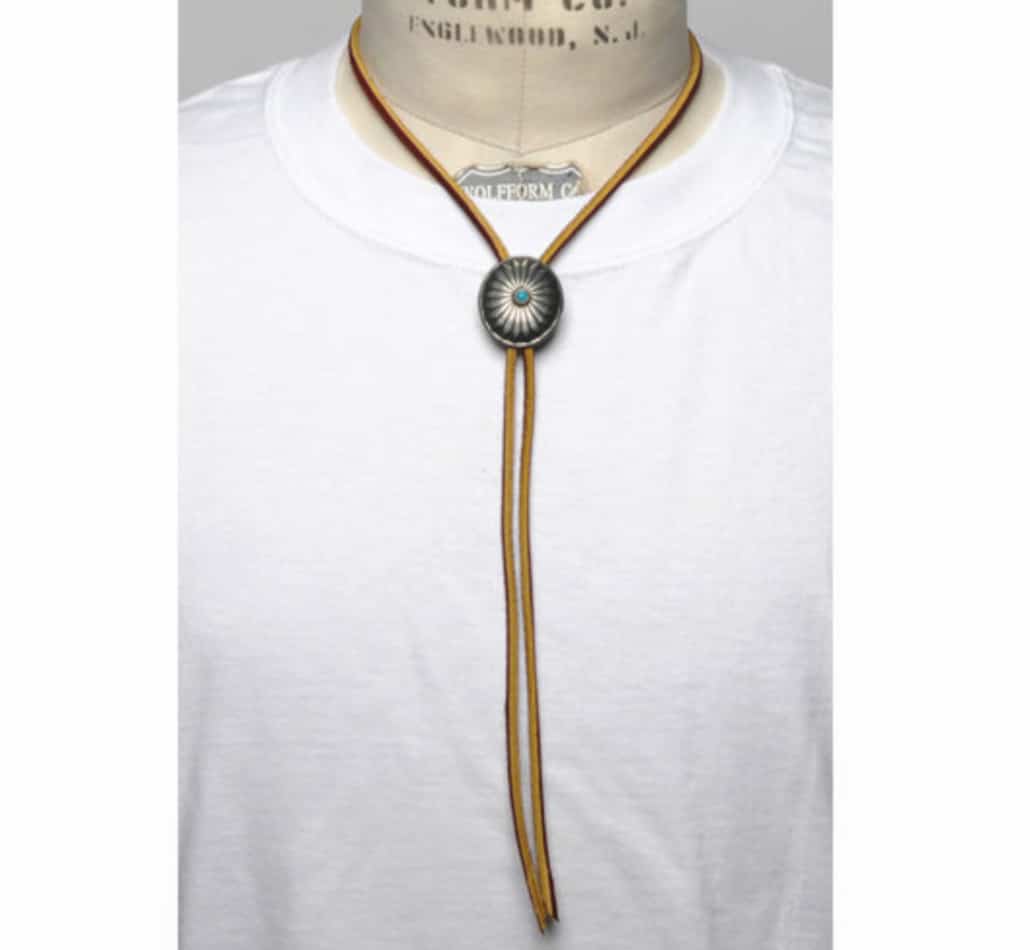
Example of a Bolo Tie
Most sources point to the creator of the bolo tie being a silversmith from Wickenburg, Arizona named Vic Cedarstaff. While out riding one day in the 1940s, Cedarstaff’s hat blew off. He retrieved it, but since he did not want to lose the hat band and buckle again, he took them off the hat and put them around his neck. Cedarstaff later added silver aglets to the ends of the band, named it after the bolas or bolos used by Argentine gauchos, and patented the design in 1959.
The bolo tie was adopted as the official state tie of Arizona in 1971, and later by New Mexico and Texas, as well. It got a boost in the fashion world in the 1980s with rockabilly and new wave musicians and also in Hollywood, but today, it’s most commonly associated with its western wear roots.
Plantation Tie

American writer Mark Twain wearing a plantation tie
Returning to ribbons, we have the plantation tie, which is also called the planter’s tie or southern colonel tie. This is a loop of dark ribbon that’s tied into a bow, using the same mechanics as a conventional bow tie. And it’s commonly associated with figures like Mark Twain and Colonel Harlan Sanders, the founder of Kentucky Fried Chicken.
Black Tie Alternatives
Continental Tie
This is a bow tie alternative consisting of a strip of fabric usually black that overlaps under the throat, where it is fastened by a tie tack or snap button. Because the tie crosses over itself, it’s also referred to as a crossover. However, the term continental tie can also be applied to a V-shaped neckband fastened behind the neck rather than in front. This style also has an alternate name, the “bulldogger tie.”
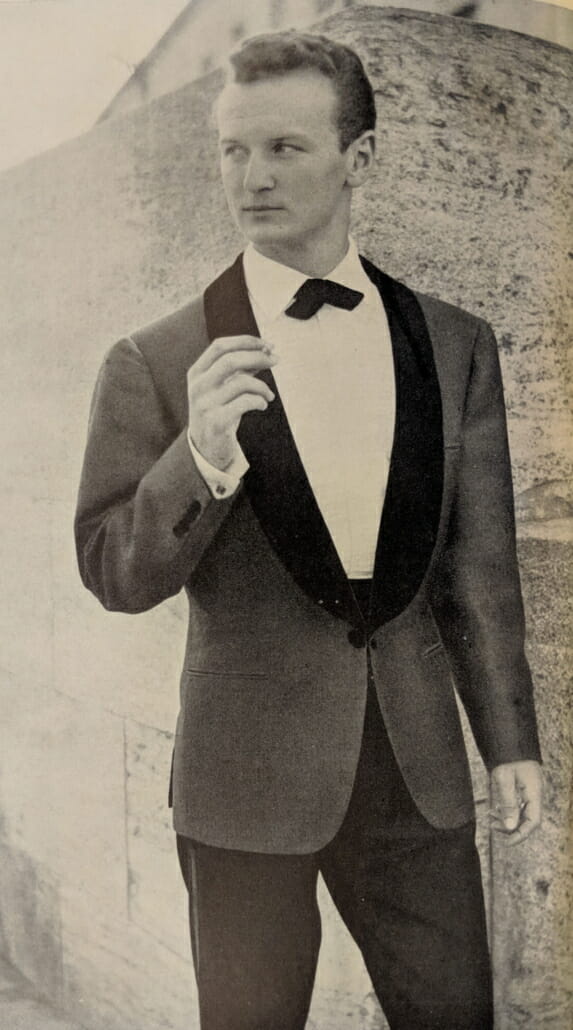
1960s French Continental Tie tucked under the shirt collar and dinner jacket with black satin faced shawl collar
Both of these continental tie styles were popular in America in the late 1950s and early ‘60s, as part of a broader fashion movement called the Continental Look, wherein the traditional full cuts of English suits gave way to slimmer and more youthful Italian styles. The Continental style overall, was tighter and closer to the torso, with slimmer pants, a more nipped-in waist, and a sleeker shoulder line. It was characterized by such details as narrow, trimmed lapels, sometimes semi-peaked in the Tautz style, and false, detachable cuffs.
Both styles of continental tie were popular with musicians of this time with the crossover seen on figures like Elvis Presley, and the V-shaped style becoming a signature fashion statement of bouzouki player Gianni Stamatiou, also known as Sporo.
Novelty Ties & Other Tie Styles

Leather ties were a bad 1980’s trend
We’d be remiss not to mention novelty ties of the 20th century in today’s roundup, as well, including such things as Christmas ties, keyboard ties, leather ties, and the infamous fish tie created by Ralph Marlin in the 1980s.
Additionally, we should also mention some 21st-century alternative tie styles, such as bow ties made from materials like wood, metal, cork, leather, or feathers. There are also more historical styles that we didn’t cover here today, for instance, things like the rosette tie among others.
When Can You Wear Alternative Neckwear?
Alternatives We Don’t Really Recommend
To some extent, it depends on the style in question. For example, we wouldn’t really recommend any of the more historical styles, such as the stock with the exception of hunting attire, the Steinkirk, or the solitaire.

Philippe Coypel 1732 painting in a solitaire
Similarly, the string tie and plantation tie are probably going to look more dated and costumey than stylish today, which can also be applied to the novelty tie category more broadly.
Either style of continental tie is probably something we’d advise against as well, simply because we’re big proponents of classic Black Tie, as exemplified by the 1930s in particular. For more information on both classic black tie as well as alternatives like the continental tie, you can consult our comprehensive Black Tie Guide.
Modern, Fashion-Forward Settings
Regarding bow ties made of non-fabric materials, they can certainly work in a more modern, fashion-forward setting. But if you’re going for a look grounded in the principles of the Golden Age of Menswear, as we advocate here at the Gentleman’s Gazette, you’re probably going to find that they’re not going to be versatile or harmonious with the other elements of your wardrobe.

Western-Inspired Outfits
And what of the bolo tie, then? Well, we wouldn’t recommend it for all situations. However, if you do happen to be in the southwestern United States, particularly one of the states that’s officially sanctioned this style, then we think you could experiment with wearing it. It would probably work best though if the rest of your outfit is similarly western-inspired, but not over-the-top or costumey but rather more subtle and traditional.
Conclusion
The world of men’s neckwear is far more vast than the two main pillars of conventional neckties and bow ties. Even so, the various alternative styles we’ve covered today have remained alternative for a reason: which is to say, they’re not nearly as versatile as their more conventional counterparts.

Visit our Fort Belvedere shop to get a great discount
For 99% of sartorial situations then, a well-chosen necktie or bow tie or perhaps an ascot or cravat is going to serve you well. Feel free to experiment with the other alternative styles if you so choose, but be aware that a more standard style is going to be best for tying your looks together.
Which of these alternative styles would you consider wearing? Share with us in the comments!
from Gentleman's Gazette https://ift.tt/3eOEVnd
- Get link
- X
- Other Apps
Comments
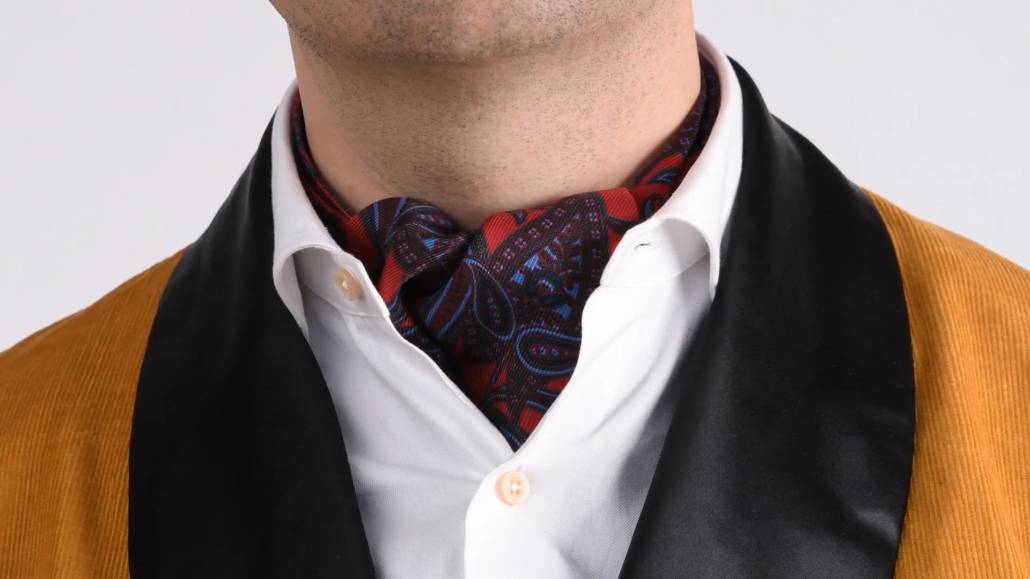
This is a blog to read out for sure. I found you have a really awesome writing style.Its simple and easy to understand.Your blog design is so clean too! Thank you for all the hard work!
ReplyDeleteWedding suit alterations Sydney